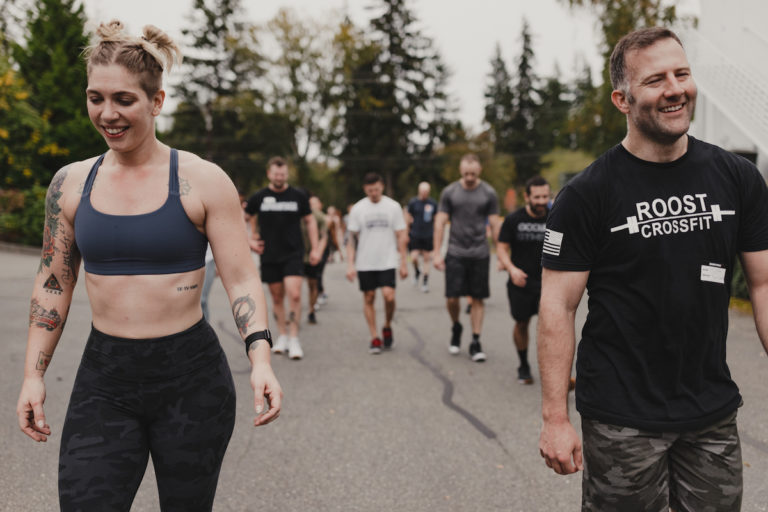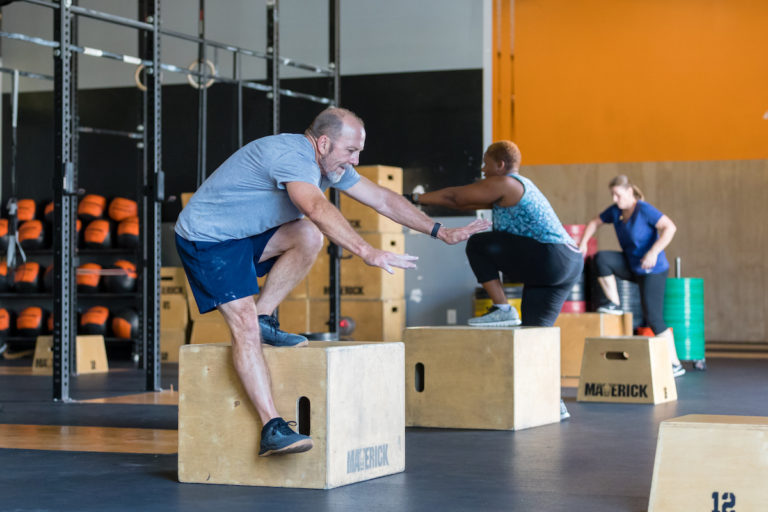CrossFit’s goal is to increase health, happiness, and performance. Ground zero for this mission is the CrossFit affiliate. The job of the coach and affiliate owner is no small task. It requires a commitment to changing behavior, inspiring athletes every day, and building confidence in athletes so they can achieve long-term improvements in health, happiness, and performance.
Our behavior can be defined as how we act in response to a stimulus, whether it be internal or external. In order to act, we must generate a hierarchy of actions based on the information coming in and our most probable behavior. People tend to make positive changes to their behavior when they believe they can be successful. This is called self-efficacy. It is one’s belief in their ability to succeed at a specific task, and it is one of the most accepted constructs in behavior change theory.
Behavior change comes in many forms, such as:
- Convincing an athlete they have what it takes to start CrossFit.
- Teaching an athlete how to scale correctly.
- Giving athletes tools to change how they respond to stress.
- Modeling how to embrace challenges.
- Teaching athletes how to improve their diet.
Fortunately, the CrossFit affiliate is set up perfectly to continuously increase self-efficacy and consequently change behavior.
A common misconception about self-efficacy is that it applies to any and all activities or tasks. But in truth, self-efficacy is task specific. In research on self-efficacy, participants are often provided a questionnaire to determine their self-efficacy for a given task. For instance, if the researchers were determining how self-efficacy was related to pull-up performance, the researcher might provide a survey that asks:
How confident are you that you can perform more than 25 pull-ups?
- Not at all confident
- Slightly confident
- Somewhat confident
- Quite confident
- Extremely confident
Researchers would then use these responses to determine self-efficacy in completing this specific task, measure the outcome of the task, and compare it to the response scores. Typically, it is found that those with higher self-efficacy scores perform better on the test. As a coach, you don’t have to walk around giving athletes self-efficacy surveys, but it is useful to ask some questions before taking on something new. For instance, on an athlete’s first day in the gym, you might say something simple like: “Welcome to your first day. Here is what we are going to do today. How do you feel about your abilities to complete this?” The answer given and how it is given can tell you a lot about this athlete. This type of self-reflection is called metacognition. The athlete is evaluating themselves, the task, and their belief in their ability to perform. If the answer is, “Well, I haven’t worked out in 15 years, and I feel like I’m terribly out of shape, so I’m expecting it to be pretty bad,” you know you’re going to have to find ways to make it a more positive experience. You’re going to have to increase their belief that they can be successful.

CrossFit Affiliate Summit, CrossFit Advantage, Oct. 17, 2021
Self-efficacy can be increased in multiple ways. One of the most impactful ways to increase self-efficacy is through mastery experiences. These are successful experiences that increase your belief in yourself to repeat that behavior. There are a lot of successful outcomes in CrossFit that can be celebrated. When it comes to the new athlete, pay close attention to progressing through a new skill, learning a new skill, increasing range of motion for a challenging movement, scaling properly to meet the stimulus of the workout, consistent attendance, or even subjective measures like a more positive attitude.
One of the best ways to make use of mastery experiences is to help your athletes create goals. These should be strategically developed to offer a challenge but also reduce the chance of failure. Goals shouldn’t be so easy that they provide a false sense of confidence, completely derailing their progress when failure finally occurs. Also, they should not be so far-reaching that they reduce confidence and diminish any established self-efficacy. Goals should be meaningful to the athlete. If there is value associated with the goal, there will be a high sense of reward when the goal is achieved.
It can be more useful to focus on process-oriented goals rather than outcome-oriented goals. If an athlete wants to get their first pull-up, provide them a strategy to get there. We’ve all heard our athletes say, “I want to get my first pull-up.” It is great to go after this endeavor, but this goal has no plan. The athlete is essentially leaving it up to chance. Without a plan, there is a higher risk of failure, and failure can diminish self-efficacy. Change the goal to, “I am going to perform 30 ring rows, 20 jumping pull-ups, and 10 negatives per day, three times per week; and increase reps by 1-2 per week, for the next six weeks.” These goals typically require effort and practice. Establishing practice as a means to developing a skill is a very important behavior in CrossFit as well as in other aspects of life. Process-oriented goals provide a roadmap for athletes to follow, and completing each day builds self-efficacy in the objective task.

Coaches should encourage their athletes to track their progress in the gym. This is easily accomplished with the use of apps. Many apps provide visual cueing of improvements, and can also be used to reframe any failures. Athletes will fail, but it can be useful to counter that experience with all the successful experiences. Reframing failures is a powerful tool for a coach. Failure becomes a learning experience, and if properly addressed can be used as a source of motivation. Turn a failure into a process-oriented goal. When an athlete is upset because they failed to PR their snatch, provide them helpful feedback on technique and set up a plan to practice snatch technique, using specific drills relative to your feedback, two days per week. This will set them up for success, and provide an opportunity for an increase in self-efficacy. For each of these approaches – strategic goals, process-oriented goals, and progress tracking – make sure to celebrate any and all victories. High fives, class and social-media mentions, or any celebration, no matter how big or small, can go a long way. As a coach, you might even have to teach your athletes that celebrating their victories is OK. They should understand that the effort they have put in to the task has paid off, and they should try to replicate that effort across all tasks moving forward. If there is a PR bell in the gym, make sure they ring it!
When it comes to changing your athletes’ behaviors, increasing self-efficacy can be instrumental. Though there are many ways to increase self-efficacy, creating mastery experiences is an accessible strategy for any coach. These little wins add up and can continue to build the confidence in your athletes to succeed.
About the Author
Michael Giardina started CrossFit in 2005. He has worked as a trainer at a CrossFit affiliate and as a CrossFit Seminar Staff Flowmaster and Content Supervisor. He has competed at the CrossFit Games and served as a CrossFit Games Head Judge. He is a Certified CrossFit Coach (CF-L4), has a Master of Science degree in exercise physiology, a Master of Public Health degree, and works as CrossFit’s Senior Manager of Health Education.
Comments on Increasing Self-Efficacy Through Mastery
Excellent article! Thank you for sharing meaningful values, like self-efficacy and mastery, that can be learned through sport!
This is great Mike. Loving the concept of process oriented goals.
Any other resources you recommend on the topic?
Increasing Self-Efficacy Through Mastery
2